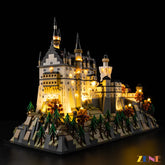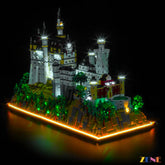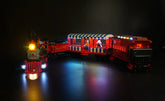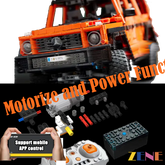Beyond the Box - A Definitive Technical Guide to LEGO Technic Power Systems
How to Motorize a LEGO Technic Car for 100% Fun
After building a complex LEGO Technic car, don't you wish you could see it accelerate, drift, and conquer terrain like a real vehicle? That dream is now a reality. High-performance power systems, smart remote controls, and professional-grade custom parts are transforming static models into roaring, high-speed machines.
The magic of LEGO Technic lies in its mechanical realism: engines, gears, drivetrains, and differentials. But instead of letting your creation gather dust on a shelf, why not give it a "soul"? This guide will dive into the world of LEGO power modifications, helping you choose the right components to achieve your goal, whether it's blistering speed or unstoppable off-road power.
1. Core Modding Goals: Speed Demon vs. Off-Road Crawler
Before you buy a single part, you must define your primary goal. LEGO modifications typically fall into two categories, and each requires a different engineering philosophy.
1.1. The Speed Demon: Pursuing Maximum Velocity
The core desire is instant acceleration and the highest possible top speed. This build prioritizes high-RPM motors paired with high-voltage power supplies. We'll compare top brands like LEGO, CADA, BuWizz, and ZENEBricks to see which delivers the most speed.
1.2. The Off-Road Crawler: Conquering Complex Terrain
The core desire is "slow and powerful" control. This build prioritizes high-torque motors, reinforced differentials, and a stable, long-range remote-control experience. The goal is to climb over obstacles like carpets, wooden ramps, and loose gravel with unstoppable crawling ability.
2. Key Component Deep-Dive: The Heart of Your Mod
The performance of your build is dictated by its components. Let's break down the three most critical parts: the motor, the power source (battery), and the differential.
(A) Power Source & Motor: The "Heart" of the Build
A motor's performance is defined by voltage (its power potential) and RPM (its speed). These two factors together determine your model's capabilities.
1. Voltage Comparison: High Voltage = High Power
Based on the formula P = V × I (Power = Voltage × Current), a higher voltage allows for greater power output. For speed demons, higher voltage is non-negotiable.
| Product Name | Max Voltage (V) | Battery Type | Notes |
|---|---|---|---|
| ZENEBricks 3S | 13.2V | External 3S LiPo (Hobby-grade) | Modular design, compatible with common, low-cost hobby batteries. |
| BuWizz 3.0 Pro | 11.7V | Internal Li-Po | "LUDICROUS" mode max output. |
| BuWizz 2.0 | 11.2V | Internal Li-Po | "LUDICROUS" mode max output. |
| LEGO Power Functions (PF) | ~9.0V | 6x AA Batteries | Voltage drops as batteries drain. Rechargeables are ~7.2V. |
| ZENEBricks 2S | 7.4V | External 2S LiPo (Hobby-grade) | Standard RC operating voltage. |
| LEGO Powered Up (PU) | ~7.3V | Internal Li-Po (in Hub) | Stable voltage from the rechargeable #88012 C+ Hub. |
Key Takeaway: The ZENEBricks 3S system is the clear voltage leader at 13.2V. Its use of standard, swappable hobby-grade batteries also makes it a cheaper and more flexible option for high-power builds.
2. RPM Comparison: The Brushless Revolution
RPM (Revolutions Per Minute) directly impacts speed. The massive gap in RPM comes from the motor technology: traditional brushed motors vs. modern brushless motors.
| Product Name | Unloaded Speed (RPM) | Motor Type |
|---|---|---|
| ZENEBricks Brushless | 50,000 (12,500 after 4:1 gear) | Brushless |
| LEGO Buggy Motor | ~1260 | Brushed |
| BuWizz Motor | ~1150 | Brushed |
| LEGO PF L-Motor | ~375 | Brushed |
| LEGO PF M-Motor | ~400 | Brushed |
| LEGO PF XL-Motor | ~220 | Brushed |
Key Takeaway:
- Brushed Motors (LEGO, BuWizz): Limited by physical friction (brushes) and heat. It has lower cost, smooth low-speed operation, and does not require electronic speed controllers (ESC). Currently, it uses interfaces from the same series as LEGO.
- Brushless Motors (ZENEBricks): Use electronic commutation, eliminating friction for insane speeds (50,000 RPM) and much longer lifespan. This is a 30-40x increase in raw speed potential. Integrated planetary gearbox and equipped with ESC.
(B) Differential: The Drivetrain "Stabilizer"
The differential is crucial for transferring power to the wheels, but it's also a common failure point. Its material and gear ratio directly impact durability and torque handling.
| Comparison | LEGO Technic Gear Differential (24-16t) | ZENEBricks High-Performance Metal Diff |
|---|---|---|
| Gear Material | All Plastic | Metal Gears (Planetary + Axle) |
| Gear Ratio | ~1.57:1 | 2.545:1 |
| Durability | Prone to slipping, grinding, and breaking under high torque/speed. | Designed to withstand extreme loads and wear from brushless motors. |
| Best Use Case | Standard builds, low-to-medium speed models. | High-performance RC MOCs, speed builds, and high-torque crawlers. |
Considering Lego's plastic gears, natural defects caused by precision and hardness, tooth skipping, and low torque issues, the actual performance will be much weaker than the parameter data above.
ZENEBricks Diff Advantage:
- Durability: Metal gears won't strip or break under the shock from a brushless motor.
- Torque Handling: The higher gear ratio (2.545:1) helps manage the motor's extreme speed, protecting the rest of your drivetrain from shredding itself.
- Plug-and-Play: The size is the same as LEGO's differential + outer frame, considering compatibility, straight. Designed as a drop-in replacement for standard LEGO diffs.
(C) Steering System: The Key to Control
A fast car is useless if you can't steer it. The steering system (servo motor) determines your control and agility.
| Model | Angle | Unloaded Speed | Voltage | Connection |
|---|---|---|---|---|
| LEGO 88004 (PF Servo) | ± 90° (15 fixed positions) | ~360°/sec | 9V / 7.2V | LEGO PF |
| LEGO 45503 (EV3 Medium) | 360° Continuous | ~240-250 RPM | 9V / 7.2V | EV3 (6-wire) |
| CADA Servo (PF-compat.) | ± 90° (15 fixed positions) | ~360°/sec | 7.4V | LEGO PF compatible |
|
ZENEBricks Geekservo 2KG 360° |
360° Continuous | 0.07 sec/60° | 4.8-6V | 3-wire (Signal/V+/GND) |
Selection Advice:
- Pure LEGO Build: Use the LEGO 88004 (PF) or EV3 motor for 100% compatibility.
- Budget Build: The CADA servo performs nearly identically to the LEGO PF servo for a fraction of the price.
- High-Performance: The ZENEBricks use Geekservo is the prochoice. Its 360° continuous rotation and faster response speed are essential for handling high-speed models. It also allows for custom programming (e.g., with a Raspberry Pi).
3. Theoretical Speed Test: How Fast Can They Go?
Let's use the LEGO Ferrari Daytona SP3 #42143 (wheel diameter 69mm) as our test model. Using the formula below, we can calculate the *theoretical maximum speed* in an ideal state (no friction, no wheel slip).
Speed Formula:max speed (km/h) = [(n / (p × p1)) × π × d × 60] / 1,000,000
(n=Motor RPM, p=Differential Ratio, p1=Planetary Gearbox, d=Wheel Diameter in mm)
(Note: the following results are from above parameters calculation.)
| Motor Model | Motor RPM (n) | Planetary Gearbox (p1) | Diff. Ratio (p) | Wheel (d) | Final Speed (km/h) |
|---|---|---|---|---|---|
| LEGO L-Motor | 375 | N/A (1) | 1.57 | 69mm | 3.11 |
| LEGO XL-Motor | 220 | N/A (1) | 1.57 | 69mm | 1.82 |
| LEGO Buggy Motor | 1260 | N/A (1) | 1.57 | 69mm | 10.44 |
| BuWizz Motor | 1150 | N/A (1) | 1.57 | 69mm | 9.53 |
|
ZENEBricks (Off Road Version) |
50000 | 16:1 | 2.545 | 69mm | 15.97 |
|
ZENEBricks (High Speed Ver.) |
50000 | 4:1 | 2.545 | 69mm | 63.89 |
Key Takeaway: The performance gap is massive. The ZENEBricks standard brushless setup is theoretically 20 times faster than a build using the standard LEGO L-Motor, 7 times faster than a build using the standard Buwizz Motor.
4. Compatibility and Installation
1. Basic Compatibility
All major brands (LEGO, CADA, BuWizz, ZENEBricks) are designed to fit the standard LEGO Technic system. They connect seamlessly with Technic axles, beams, and pin holes, requiring no permanent modification to your model.
2. Advanced Advantages (ZENEBricks)
- Modular Integration: The brushless driver module although there is an extra integrates the ESC (Electronic Speed Control) and control logic, making it plug-and-play without complex wiring.
- Long-Range RC: Uses a 2.4GHz hobby-grade transmitter and receiver, offering a control range of up to 400m. BuWizz's Bluetooth range (60-100m) and is more stable, especially for multiple players.
- Cost-Effective: Compatibility with standard hobby batteries (around $20) is much cheaper than proprietary battery packs. Easy to obtain universal batteries for model aircraft, more standardized and safer.
5. LEGO Power Modding: A Cost-Benefit Analysis
When choosing the right power system for your LEGO Technic model, cost is just as important as performance. The price difference between brands and systems is vast, ranging from a simple, cheap upgrade to a high-performance kit that costs more than the original LEGO set.
This analysis breaks down the estimated costs for a complete power system based on the components discussed in this guide.
Important Disclaimer: All prices are estimates based on average online retailers (Amazon, AliExpress, brand websites, LEGO Shop, etc.). Actual prices can and will vary significantly based on the seller, your region, active sales, and stock availability. This comparison is for budget planning purposes only.
1. Estimated Cost for Key Components
First, let's look at the approximate individual costs for the core components needed to build a full system.
| Component Type | Brand / Model | Est. Price (USD) | Notes |
|---|---|---|---|
|
Power/Control Core (Battery + Receiver) |
LEGO Power Functions (PF) AA Battery Box | $15 - $25 | Discontinued, price is unstable. Receiver not included. |
| LEGO PF IR Receiver | $15 - $20 | Required to go with the PF Battery Box. | |
| LEGO Powered Up (PU) C+ Hub (#88012) | $80 - $90 | Includes Bluetooth receiver and rechargeable battery. | |
| CADA Power Box (incl. Remote/Receiver) | $20 - $30 | All-in-one unit (Battery + Bluetooth + High Voltage). | |
| BuWizz 2.0 / 3.0 Pro | $130 - $200 | All-in-one unit (Battery + Bluetooth + High Voltage). | |
| ZENEBricks Driver Module (incl. Receiver) | $60 - $80 | Requires a brushless motor and transmitter. | |
| Remote Control | LEGO PF IR Remote | $10 - $15 | |
| LEGO PU Remote (#88010) | $25 - $30 | ||
| ZENEBricks 2.4Ghz Transmitter | $30 - $40 | Often bundled with the Driver Module. | |
| Motor (Drive) | LEGO PF L-Motor | $15 - $20 | |
| LEGO PU L-Motor (#88013) | $35 - $40 | ||
| LEGO Buggy Motor | $40 - $60 | Rare, high-performance brushed motor. | |
| CADA Pro Motor | $10 - $15 | ||
| ZENEBricks Brushless Motor | $40 - $50 | Requires ZENEBricks Driver Module. | |
| Motor (Steering) | LEGO PF Servo Motor (#88004) | $25 - $30 | |
| CADA Servo Motor | $8 - $12 | ||
| Geekservo 2KG 360° | $5 - $10 | Used for ZENEBricks and other RC systems. | |
| Pro Parts | ZENEBricks Metal Differential | $25 - $30 | Required for extreme performance mods. |
| Hobby-grade 2S/3S LiPo Battery | $15 - $25 | Required for ZENEBricks system. |
2. Typical Modding Solution Cost Comparison (Full System)
You can't just compare the price of a single motor. A BuWizz brick is expensive, but it includes the battery and controller. We must compare the total cost to get a fully functional system (e.g., 2 drive motors, 1 steering motor, power, and remote control).
| Solution | Power/Control Core | Drive Motors (x2) | Steering Motor (x1) | Est. Total Cost (USD) | Key Features |
|---|---|---|---|---|---|
| 1: Budget-Friendly (CADA) | CADA Power Box (incl. Remote) | CADA Pro Motor (x2) | CADA Servo (x1) | $45 - $65 | Extremely low cost. Performance is similar to LEGO PF. Perfect for beginners. |
| 2: LEGO Purist (LEGO PU) | LEGO PU C+ Hub (#88012) | LEGO PU L-Motor (x2) | LEGO PU L-Motor (x1) | $185 - $210 | Official solution. Bluetooth app control, perfect compatibility, but very expensive and lacks a true servo. |
| 3: All-in-One Perf. (BuWizz) | BuWizz 3.0 Pro | BuWizz Motor (x2) | LEGO PF Servo (x1) | $225 - $270 | Highest cost. Cleanest installation (all-in-one brick), high voltage output, app control. |
| 4: Extreme Perf. (ZENEBricks) | ZENEBricks Driver (incl. Remote) + 3S LiPo | ZENEBricks Brushless (x2) | Geekservo (x1) | $200 - $245 | High performance. Cost is similar to LEGO PU, but provides brushless speed and a proper RC remote. |
*ZENEBricks solution may also require a metal differential and a LiPo charger included in this total.
3. Cost Analysis & Summary
To visualize the difference, here is a bar chart comparing the total cost of the four complete solutions.
Cost Conclusion
- The Value King (CADA): ZENEBricks also offers unparalleled value. If you just want to motorize a model cheaply and are not chasing extreme performance, this is the smartest choice.
- The Purist's Choice (LEGO PU): The official LEGO PU system is one of the most expensive routes. You are paying a premium for the brand and app integration, but you are limited by its (lack of) servo and lower voltage.
-
The Performance Benchmarks (ZENEBricks & BuWizz): This is a direct trade-off.
- BuWizz an expensive, clean, all-in-one solution that just works. It's the easiest way to get higher than normal Power Functions.
- ZENEBricks offers the best performance-per-dollar. For a similar total cost as the LEGO PU system, you get a full-blown brushless setup with RC control and the highest voltage potential. It's less "clean" than BuWizz but more powerful.
6. Your 4-Step Professional Modding Guide
Modding isn't just about piling in parts. Follow this systematic process for a stable and high-performance build.
-
Step 1: Define Your Goal
- Speed: Prioritize high voltage (ZENEBricks 3S), a brushless motor, and a metal differential.
- Off-Road: Focus on high-torque motors, a reinforced differential, and a long-range RC system. Extreme voltage is less important than control.
-
Step 2: Select Your Power Kit
- LEGO Purist: Use the LEGO Powered Up (PU) system for full compatibility, best for light mods.
- Budget-Friendly: ZENEBicks Normal power pack Versions use similar with CADA motors offer performance similar to LEGO PF for less money.
- Max Performance: The ZENEBricks brushless kit is the clear choice for serious speed and durability.
-
Step 3: Adjust the Model Structure
- Make Space: Re-engineer parts of the chassis to fit the new motor, battery, and control module.
- Cable Management: Route all wires carefully to prevent them from getting caught in gears or axles.
- Reinforce: High speeds and torque will shake your model apart. Add extra beams and pins to strengthen the chassis and drivetrain.
-
Step 4: Integrate and Test
- Tune Controls: Adjust the steering sensitivity and throttle curve on your controller for a smooth driving experience.
- Field Test: Test the car in its intended environment (smooth floors for speed, obstacles for off-road).
- Optimize: Watch for weaknesses. Does a gear skip? Does the chassis flex? Reinforce, adjust, and test again.
Conclusion
The core of LEGO Technic power modding is simple: "Bring the mechanics to life." Whether you crave the thrill of high-speed racing or the satisfaction of crawling over any obstacle, choosing the right components is key.
While official LEGO parts are great for simple motorization, third-party brands like ZENEBricks have filled the performance gap, making professional-grade, high-speed mods accessible to everyone. Don't be afraid to experiment—your ultimate Technic creation is waiting to be unleashed.
















Leave a comment
Please note, comments need to be approved before they are published.